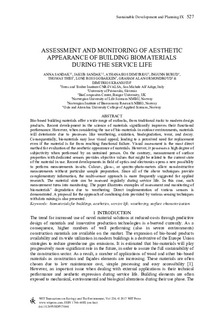| dc.contributor.author | Sandak, Anna | |
| dc.contributor.author | Sandak, Jakub | |
| dc.contributor.author | Dimitriou, Athanasios | |
| dc.contributor.author | Burud, Ingunn | |
| dc.contributor.author | Thiis, Thomas Kringlebotn | |
| dc.contributor.author | Gobakken, Lone | |
| dc.contributor.author | Ormondroyd, Graham Alan | |
| dc.contributor.author | Kraniotis, Dimitrios | |
| dc.date.accessioned | 2018-02-22T10:03:37Z | |
| dc.date.available | 2018-02-22T10:03:37Z | |
| dc.date.created | 2018-01-31T18:11:14Z | |
| dc.date.issued | 2017 | |
| dc.identifier.citation | Wit Transactions on Ecology and The Environment. 2017, 226 527-536. | nb_NO |
| dc.identifier.issn | 1743-3541 | |
| dc.identifier.uri | http://hdl.handle.net/11250/2486355 | |
| dc.description.abstract | Bio-based building materials offer a wide range of outlooks, from traditional rustic to modern design products. Recent development in the science of materials significantly improves their functional performance. However, when considering the use of bio-materials in outdoor environments, materials will deteriorate due to processes like weathering, oxidation, biodegradation, wear, and decay. Consequentially, biomaterials may lose visual appeal, leading to a perceived need for replacement even if the material is far from reaching functional failure. Visual assessment is the most direct method for evaluation of the aesthetic appearance of materials. However, it possesses a high degree of subjectivity when performed by an untrained person. On the contrary, measurement of surface properties with dedicated sensors provides objective values that might be related to the current state of the material in use. Recent developments in field of optics and electronics opens a new possibility to perform measurements in-situ. Colour-, gloss-, or spectro-photo-meters allow non-destructive measurements without particular sample preparation. Since all of the above techniques provide complementary information, the multi-sensor approach is more frequently suggested for applied research. The material state can be assessed regularly during service life. In this case, such measurement turns into monitoring. The paper illustrates examples of assessment and monitoring of biomaterials’ degradation due to weathering. Direct implementation of various sensors is demonstrated. A proposal for the approach of combining data provided by various sensing techniques with data mining is also presented. | |
| dc.language.iso | eng | nb_NO |
| dc.rights | Attribution-NonCommercial-NoDerivatives 4.0 Internasjonal | * |
| dc.rights.uri | http://creativecommons.org/licenses/by-nc-nd/4.0/deed.no | * |
| dc.title | Assessment and monitoring of aesthetic appearance of building biomaterials during the service life | nb_NO |
| dc.type | Journal article | nb_NO |
| dc.type | Peer reviewed | nb_NO |
| dc.description.version | publishedVersion | |
| dc.source.pagenumber | 527-536 | nb_NO |
| dc.source.volume | 226 | nb_NO |
| dc.source.journal | Wit Transactions on Ecology and The Environment | nb_NO |
| dc.identifier.doi | 10.2495/SDP170461 | |
| dc.identifier.cristin | 1559533 | |
| cristin.unitcode | 192,15,0,0 | |
| cristin.unitcode | 192,14,0,0 | |
| cristin.unitname | Realfag og teknologi | |
| cristin.unitname | Miljøvitenskap og naturforvaltning | |
| cristin.ispublished | true | |
| cristin.fulltext | original | |
| cristin.qualitycode | 1 | |

